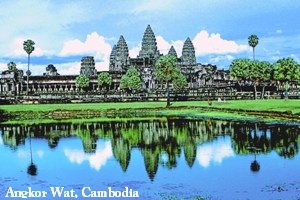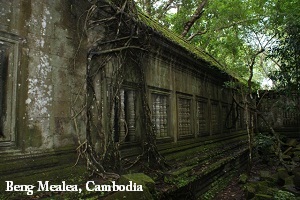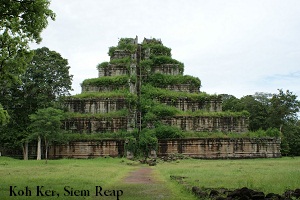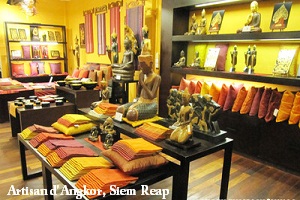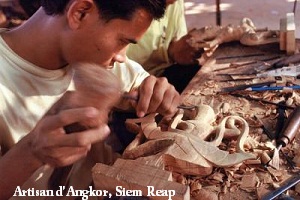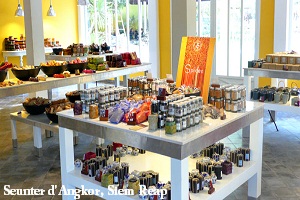|
Most visitors to Siem Reap are there to visit the famed Temples of Angkor. These spectacular ruins from the 9-14th centuries are an adventurer's dream. Located just 7km from the entrance gate, Siem Reap has become a popular stop on the tourist trail of Asia. Once was a sleepy town full of farms and small shops, the increase in tourists over the past 15 years has turned this town into a tourism mecca. Modern hotels, internet cafes, and international restaurants are a welcome treat after a day spent exploring the temples in the Cambodian heat. Yet, Siem Reap retains its small town charm and visitors who take the time to explore the town and its surroundings are rewarded with a deeper insight in to Cambodian culture and lifestyle.
The magnificent Angkor complex, whose stone ruins stand testament to the power of the once vast and glorious Khmer Empire. Today, declared a World Heritage Site, the area is dotted with over 1000 temples and pagodas, from unadorned ruins scattered through rice fields to the awe imposing Angkor Wat; the smilling faces of the Bayon; the encroaching jungle upon Ta Prohm; and the delicate carvings of the vibrant pink sandstone at Banteay Srei, all of which make Angkor one of the world’s greatest man made wonders.
Although a three night stay is the perfect amount of time for exploring the temples, however we strongly recommend a longer stay to truly experience Siem Reap and its many wonders.
What to see in Siem Reap?
Of course, no visitor to Siem Reap could afford to miss a visit to the Temples of Angkor (Angkor Map). Over 100 temples lie within the Siem Reap province dating from the 9th-14th century. We recommend at least 3 full days for temple exploration. This will allow you to see all of the main temples, plus a few outlying ruins without racing around.
Any itinerary always includes Angkor Wat, the magnificent legendary temple and one of the biggest religious structures in the world. The temple’s greatest sculptural treasure is its 1 mile long bas-relief that wraps around the walls of the outer gallery along with the figures of Khmer Devas and Apsaras. Angkor Wat is stunning at any time of the day, but sunrise and sunset are especially beautiful times to watch the play of light on the stones.
Angkor Thom is the heavily fortified city built in the 10th century by the greatest of the Khmer rulers by King Jayavarman VII (1181 - 1201). With a population in excess of one million inhabitants, Angkor Thom covered an area of 10 square kilometres and was larger than any city in Europe at the time. The remarkable South Gate of the city impressed visitors by the statues of 54 gods on the left and 54 devils on the right, all seemingly engaged in a game of tug of war yet in fact they are enacting the famous scene from the Churning Sea of Milk bas-relief. Bayon temple, the biggest and finest structure in Angkor Thom, is another favorite with its mysterious faces smiling down on visitors. The nearby Royal enclosures including Elephant Terrace and Terrace of the Leper King are significantly complimentary.
Ta Prohm temple - a unique jungle temple which is captivated by the large trees and vines that have grown over it. For the majority of visitors, it is the most romantic experience of Angkor and even Historians have noted its mystical charm. This temple has been featured in several Hollywood movies such as Tomb Raider, Indiana Jones and Two Brothers. Other temples in the vicinity worth seeing are Phnom Bakeng, Pre Rup, Baphoun, Srah Srang, Banteay Kdie, Ta Som, Neak Pean and Preah Khan.
If you have more time, trips further afield lead to less crowded temples and spectacular photo opportunities. Just 12 km from Siem Reap are the Rolous Group of temples, some of the earliest ruins in the region and the site of the ancient Khmer civilization of Harharalaya that flourished in the late 9th and 10th centuries. The petite Banteay Srey features intricate carvings in pink sandstone and nearby Banteay Samre is a hidden gem tucked away in the jungle.
Deep in the jungle, a visit of secluded Kbal Spean, known as the river of the Thousand Lingas, is highly recommended and perfect for a short trekking and picnic lunch. The rocks of the river have been carved (11th-13th Century), which gives it a magical touch.
The Sacred Kulen Mountain or Phnom Kulen – located about 48km from Siem Reap. Its highest point is 487 meters. Over 1000 carvings of Yoni and Linga are etched into the sandstone riverbed. The waters are regarded as holy, given the sacred carvings which also include a stone representation of the Hindu god Vishnu lying on his serpent Ananta, with his wife Lakshmi at his feet. A lotus flower protrudes from Vishnu’s navel bearing the god Brahma. The river then ends with a beautiful waterfall. Phnom Kulen is regarded highly by Cambodian people as a sacred location and has developed into a great tour destination.
Hidden Beng Melea sprawls across one square kilometer and remains covered in trees, roots, and vines. Constructed in a similar style to Angkor Wat yet overrun by nature, Beng Melea is a truly adventurous place to visit located about 65 Km ( 1.5-hour drive) from the town . The remains of Boeng Mealea, which are still partly buried under vegetation, consist of perfectly squared-off sandstone building blocks.
There are several options for getting around the temples. Car, bus, and van remain the vehicles of choice, but we recommend taking a day to cycle through the temples. Traveling by two wheels, either by regular bike, gives you a unique perspective and an eco-friendly way to see the temples. Elephant Rides are available at Bayon temple and you’ll feel as if you’ve stepped back in time to the days of the Angkorian kings as you meander through the woods and temples. A tethered hot air balloon is available near Angkor Wat which gives distant, but sweeping views of the temples and their surroundings. But the most exciting experience available is a helicopter flight around the area. Ranging in length from 8 minutes to a half day excursion, buzzing around the temples in a helicopter is an unparalleled experience.
Need a break from temple touring?
Siem Reap has several other activities and opportunities for travelers. Activities to experience in the town of Siem Reap include watching a traditional Cambodian “apsara” dance performance and participating in a Khmer cuisine cooking class. The rural outskirts offer plenty of interesting activities such as visiting craft shops and silk farms, taking a bike ride through the scenic countryside, or participating in a humanitarian assistance program by making a pump well donation or helping children at an orphanage.
A boat trip on the Tonle Sap Lake should also not be overlooked. Each year during the rainy season, the lake swells to five times larger and the plethora of fish provide the livelihood for the lake’s residents. Set off on a local wooden cruising boat to visit Kampong Phluck takes you through the floating villages and ancient mangrove forests of the lake, a great way to see the unique lifestyle of the lake’s residents. Kampong Kleang village- 35km east of Siem Reap, this lesser visited village is home to stilted houses encased by flooded forests. Witness the amazing ecosystems of the area and absorb the tranquil rhythms of life on the lake.
Artisan’s D’Angkor is a unique organization working to preserve traditional Khmer arts and crafts. They have established two centers in Siem Reap. The location in town features a stone carving workshop where locals produce magnificent sculptures, while the silk centre is a bit further afield. Here you can see the entire process of silk creation: from the breeding of the silk worms, to the dyeing and weaving of the material.
Witness traditional Khmer silk production at the Puok Silk Farm located in the lush countryside nerby to Siem Reap. You will observe how the local silk is produced from the cultivation of mulberry bushes to silk spinning, the actual silk weaving and the finished products.
Fighting an Underground War - Learn more about the scourge of landmines and the shadow they cast over rural communities in Cambodia with a visit to this flagship museum that promotes mine awareness and education.
Siem Reap’s small downtown turns in to a hive of activity as the sun begins to set. The small ‘Old Market’ closes down and tourists flood in to town to enjoy cocktails on ‘Pub Street’ and dinner in one of the many restaurants. Vendors have capitalized on this area’s popularity by establishing a night market at the south end of Pub Street. Cambodian crafts such as artwork, silks, carvings, and t-shirts are for sale in an open air market off a tranquil side street making it the perfect place to pick up souvenirs.
A traditional Apsara Dance performance is a great evening activity as the elegant dancers, elaborate costumes, and live music create an enchanting atmosphere. Another treat is a traditional massage at our favorite shop, Bodia Spa. Here you will be treated to a relaxing spa or massage treatment, using top quality natural products and traditional techniques.
Golf Getaway - Tee it off in Angkor – Within its ground stands a magnificent ancient capital offers few international standard and intelligently designed incorporating the latest innovations of golf professionals such as Phokeethra Country Club and Angkor Golf Course.
Cambodia is regular host to the Johnnie Walker Cambodian Open golf tournament. The Angkor Golf Resort is designed by six-time big winner Nick Faldo and it is claimed that this course could emerge as not only the finest in Cambodia, but one of the best in the Asia-Pacific region. This 18-Hole course is a challenging 7279 yards, par 72 that is built to challenge all levels of golfers and has been rated by the US PGA.
Khmer Cooking Course - Discover the secrets of authentic Khmer cuisine in a half day cooking class. Begin with a trip to the colorful local market with a recipe led by a Khmer Chef before returning to the classroom for a hands-on culinary experience and finally enjoy it as your lunch.
Other key destinations outside Siem Reap:
Preak Toal (Battambang): Osmose, a not-for-profit association, which has implemented a pilot conservation project in Prek Toal area. The site is critical for the survival of several species of endangered waterbirds. Embark on a wooden boat for a day cruise. Cross the Tonle Sap lake to reach Prek Toal village and continue on a pirogue ,with an experienced ornithologist, to the wild-bird sanctuary. Enjoy bird watching such as storks, adjutants, pelicans and ibis.
Koh Ker, situated to the northeast of Siem Reap (130 Km), is the remnants of the Khmer capital in the late 9th century and features a circular loop of about a dozen ruins. The most impressive temple at Koh Ker is Prasat Thom, a giant pyramid spanning seven levels (35 meters high), offering major views of the surrounding country.
Preah Vihear, the temple complex built on a crest of the Dangkrek Mountains at an altitude of 730 m at the Thai-Cambodian border and now accessible from the Cambodian side as well as from the Thai side is to be seen. The excursion from Siem Reap will be done in 2 days via Along Veng as it takes more than 6 hours to reach Preah Vihear. This amazing site is only accessible by 4 wheel drive and the view from the top of the mountain is simply beautiful and peaceful. Preah Vihear temple has declared as a world heritage by UNESCO in July 2008.
The secluded Bantey Chmar temple is located 70 km north of Sisophon (about 180 Km from Siem Reap). The rarely visited temple has been built by Jayavarman VII and dedicated to his sons killed in a battle repelling a Cham invasion in 1177. Banteay Chhmar, in critical need of conservation; work is being carried out to restore its proud towers and awesome temples, one of the few temples to feature the enigmatic Bayon-style giant faces with their mysterious smiles.
Sambor Prei Kuk (Kampong Thom province), a pre-angkorian temple site dating back to the 7th century, was known as Ishanapura, the capital of the Chenla kingdom. Probably the most interesting temples predating Angkor, the complex is composed of four groups of temples. Tucked in the forest, these ancient ruins can be explored on foot or by bike traversing small dirt paths which wind among the temples. Kampong Thom is located between Siem Reap and Phnom Penh and is an excellent stopover for those traveling overland. The site is located only 30 minutes by car north of Kompong Thom.
Battambang - Sitting on the Sangker River, a tranquil, small body of water just south west of the Tonle Sap Lake, Battambang town is at the heart of Cambodia's 'rice bowl' and presents visitors with a charming and picturesque setting.
The second-largest city in Cambodia, Battambang has a population of over 250,000. It is located a two hour drive west from Siem Reap and four hours from Phnom Penh. A world apart from Phnom Penh urban bustle it enjoys an unhurried, relaxed pace and a reputation for friendliness and pleasant atmosphere.
Founded in the 11th century by the Khmer Empire, the province is home to some of the best-preserved French colonial architecture remaining, following the French departure. Outside of the main city the two main attractions are harbor old pagodas, Prasat Wat Ek Phnom, hilltop Wat Banan - one of the best preserved Angkorian temples around Battambang, and Phnom Sampeu, the sacred mountain and killing caves used by the Khmer Rouge.
Phare Ponleu Selpak, a non profitable association with the aim to give the opportunity to young khmer children from poor or disabled families to have access to the culture via different artistic activities. The association located in Battambang welcomes daily the children to the centre to draw, play music, practise circus acts and partake in various extracurricular activities.
Note: Boat Journey from Battambang to Angkor (or v.v) takes about 5-6 hours from August to March (during the low water period from April to July the cruise is not possible due to the low level). It is an excellent way to discover the countryside and to observe the daily life along the river, the floating villages and the wildbirds of the Tonle Sap Lake.
|




